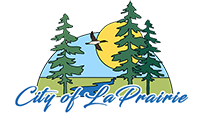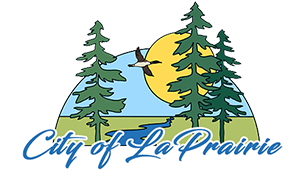
- Details
2023 Scott Olson Memorial Run Results

Winners:
Billy Sacket – 1st Place
Daniel Olson – 2nd Place
Brenden Grubbs – 3rd Place (not pictured)
While the rain put a damper on the runners, fun was had by all! Mayor Bolen, and Council Members Mike Nelson and Ken Larson prepared pancakes and sausage for the group.

- Details
Scott Olson Memorial 5K

- Details
Rink Schedule 22/23
CITY OF LA PRAIRIE RINK SCHEDULE FOR 2022/2023
The large Rink is for Open Hockey and the smaller Rink for Open Skating.
NOTE: The Warming House will be open during the weekdays and vacation days as noted on the schedule below. A Rink Attendant will be present from 4:30 p.m. - 8:30 p.m. on Weekdays and 12:00 p.m. to 9:00 p.m. on Weekends.
Schedule may be adjusted for Maintenance/flooding or due to weather conditions -10 degrees actual, -20 degrees wind chill and temperatures above freezing.
Monday through Friday:
8:30 a.m. – 8:30 p.m.
Weekends:
12:00 p.m. – 9:00 p.m.
***NOTE***
*** IMPORTANT NOTICE TO SKATERS AND PARENTS***
Please read all park and rink rules. Be sure you understand and obey them to avoid the consequences. These rules will be enforced for everyone’s safety and all our enjoyment.

- Details
Welcoming Communities of Itasca County Survey

- Details
Flooding and Flash Floods
FLOODING AND FLASH FLOODS
If you are seeking the latest information on Spring Flooding, visit our dedicated webpage. Click here to be directed to that page.
Nationally, floods claim nearly 200 lives each year, force 300,000 people from their homes, and result in property damage in excess of $2 billion. In 2019, six out of the nine state and federally-declared disasters in Minnesota involved some sort of flooding.
About 75 percent of flash-flood deaths occur at night. Half of the victims die in automobiles or other vehicles. Many deaths occur when people drive around road barricades that clearly indicate that the road is washed out ahead.
For extensive information, resources and data about flooding in the U.S. from the National Weather Service (NWS) download the NWS Information book: Floods, The Awesome Power or visit the NWS Flood Safety website.
General Flood Preparedness
Before a Flood
Spring and summer rainfalls can be heavy and can produce flash floods in a matter of hours. However, there are a few common sense preparations everyone can take to reduce their risks from harm and property destruction. The following lists a few steps everyone can take to prepare for any type of flood emergency:
- Assemble an emergency supply kit that includes enough provisions for you and your family to live on for a minimum of three days.
- Make an emergency plan for you and your family and share it with them.
Learn about the emergency plans that have been established in your area by your state and local government. - Get a NOAA Weather Radio. Listen for information and warnings.
- Elevate appliances such as the furnace, water heater and electric panel in your home if you live in an area that has a high flood risk.
- Consider installing "check valves" to prevent flood water from backing up into the drains of your home. As a last resort, use large corks or stoppers to plug showers, tubs, or basins.
- If feasible, construct barriers to stop floodwater from entering the building and seal walls in basements with waterproofing compounds.
- Get Flood Insurance. Property insurance does not typically cover flood damage. Talk to your insurance provider about your policy and consider if you need additional coverage. You may also want to learn about the National Flood Insurance Program at www.FloodSmart.gov
Review this Flood Safety Checklist for more ways to prepare and protect your home
Driving Safety
- Six inches of water will reach the bottom of most passenger cars causing loss of control and possible stalling.
- A foot of water will float many vehicles.
- Two feet of rushing water can carry away most vehicles including sport utility vehicles (SUV’s) and pick-ups.
What to do in a Flash Flood
Flash floods occur within six hours of the beginning of heavy rainfall. Below are some guidelines for keeping safe during a flash flood:
- Be prepared to evacuate and go to high ground immediately.
- Get out of areas subject to flooding, such as low spots, canyons, washes, etc.
- Do not attempt to cross a flowing stream on foot. Even water only six inches deep, when moving at a high rate of speed, can knock you off your feet.
- Never drive through flooded areas or standing water. Shallow, swiftly flowing water can wash a car from a roadway. Also, the roadbed may not be intact under the water.
- If the vehicle stalls, abandon it immediately and seek higher ground. Rapidly rising water may engulf the vehicle and its occupants.
- Be especially cautious at night when it’s harder to recognize flood dangers.
- Do not camp or park your vehicle along streams and washes, particularly during threatening conditions.
- Understand the difference between a Flash Flood Watch and a Flash Flood Warning
Know the Terms
|
Flash Flood Watch |
Flash Flood Warning |
|
Flooding is possible. Tune in to NOAA Weather Radio, commercial radio, or television for information |
Flooding is occurring or will occur soon; if advised to evacuate, do so immediately. |
Related Resources
Are you Ready? Review this Flood Safety checklist from the Red Cross.
The University of Minnesota Extension has an extensive library of disaster preparedness, response and recovery resources. This website has fact sheets, pages, guidebooks and videos with research-based tips on immediate and long-term flood issues.
For questions about water, crops, horticulture, and climatology issues call the UMN Flood Information Hotline at 1-800-232-9077, or email at This email address is being protected from spambots. You need JavaScript enabled to view it..
For information about getting flood insurance go to the National Flood Insurance Program (NFIP).

- Details
Tornado Safety Information
TORNADO SAFETY INFORMATION
What To Do During a Tornado
Tornado Safety Tips from the National Weather Service
In a House With a Basement
Avoid windows. Get in the basement and under some kind of sturdy protection (heavy table or work bench), or cover yourself with a mattress or sleeping bag. Know where very heavy objects rest on the floor above (pianos, refrigerators, waterbeds, etc.) and do not go under them. They may fall down through a weakened floor and crush you.
In a House With No Basement
Avoid windows. Go to the lowest floor, small center room (like a bathroom or closet), under a stairwell, or in an interior hallway with no windows. Crouch as low as possible to the floor, facing down; and cover your head with your hands. A bath tub may offer a shell of partial protection. Even in an interior room, you should cover yourself with some sort of thick padding (mattress, blankets, etc.), to protect against falling debris in case the roof and ceiling fail.
In an Apartment, Dorm or Condo
If you live in an apartment that is on an upper floor, get to the lowest level of the building that you can immediately. This could be an underground parking garage or a neighbor’s first floor apartment. Then move to the most interior area possible, away from windows.
If you live in a high-rise apartment building, you may not have enough time to get to a lower level, so picking a place in the hallway in the center of your building is the best idea such as a stairwell. If that is not available then a closet, bathroom or interior hall without windows is the safest spot in your apartment during a tornado. Power loss during a tornado storm is common, so avoid elevators and keep a flashlight handy.
In an Office Building, Hospital or Store
Follow instructions from facility managers. Go directly to an enclosed, windowless area in the center of the building -- away from glass and on the lowest floor possible. Then, crouch down and cover your head. Interior stairwells are usually good places to take shelter, and if not crowded, allow you to get to a lower level quickly. Stay off the elevators; you could be trapped in them if the power is lost.
In a Mobile Home
Get out! Even if your home is tied down, you are probably safer outside, even if the only alternative is to seek shelter out in the open. Most tornadoes can destroy even tied-down mobile homes; and it is best not to play the low odds that yours will make it. If your community has a tornado shelter, go there fast. If there is a sturdy permanent building within easy running distance, seek shelter there. Otherwise, lie flat on low ground away from your home, protecting your head. If possible, use open ground away from trees and cars, which can be blown onto you.
At a School
Follow the drill! Go to the interior hall or room in an orderly way as you are told. Crouch low, head down, and protect the back of your head with your arms. Stay away from windows and large open rooms like gyms and auditoriums.
In a Car or Truck
Vehicles are extremely dangerous in a tornado. If the tornado is visible, far away, and the traffic is light, you may be able to drive away from its path by moving at right angles to the tornado. Otherwise, park the car as quickly and safely as possible -- out of the traffic lanes. Avoid seeking shelter under bridges, which can accelerate the wind while offering little protection against flying debris.
In The Open Outdoors
If possible, seek shelter in a sturdy building. If not, lie flat and face-down on low ground, protecting the back of your head with your arms. Get as far away from trees and cars as you can; they may be blown onto you in a tornado.
In a Shopping Mall, Large Store or Stadium
Listen for instructions from building security. Watch for others. Move as quickly as possible to an interior bathroom, storage room or other small enclosed area, away from windows. Move away from any glass.
In a Church or Theater
If possible, move quickly but orderly to an interior bathroom or hallway, away from windows. Crouch face-down and protect your head with your arms. If there is no time to do that, get under the seats or pews, protecting your head with your arms or hands.

- Details
Heat Waves
- Details
Dog Found in LaPrairie

Male Bull Dog found in LaPrairie - contact 218-259-5649 for more information!

- Details
Hwy 2 resurfacing from Grand Rapids to Hwy 200 detour changes August 4
Construction on Hwy 2 from the Prairie River east of Grand Rapids to two miles east of Hwy 65 in Itasca County will continue with a detour change on August 4. Hwy 2 will now be closed between the Prairie River east of Grand Rapids to two miles east of Swan River. The new Hwy 2 detour for local access will utilize Itasca County Rd 3 between Grand Rapids and Jacobson and Hwy 200 between Jacobson and the junction of Hwy 2 East of Swan River.
Hwy 2 between Hwy 65 in Swan River and the east junction of Hwy 200 will no longer be open and will be closed to through traffic. The truck detour will also utilize Hwy 169 South of Grand Rapids and Hwy 200 between Hill City and Hwy 2 east of Jacobson.
Local traffic will be able to access businesses and properties in the construction zone, but through traffic will need to take the detour. For maps and more information, please visit: http://www.dot.state.mn.us/d1/projects/hwy2-reclaim/index.html
Important reminders for motorists regarding work zone safety:
- Slow down when approaching every work zone, then navigate through with care and caution.
- Stay alert; work zones constantly change.
- Watch for workers and slow moving equipment.
- Obey posted speed limits. Fine for a violation in a work zone is $300.
- Minimize distractions behind the wheel.
- Be patient; expect delays, especially during peak travel times.
For more information on projects in northeast Minnesota, follow us on Facebook at https://facebook.com/groups/MnDOTnortheast and Twitter at @mndotnortheast. For real-time traffic and travel information in Minnesota, visit www.511mn.org.

